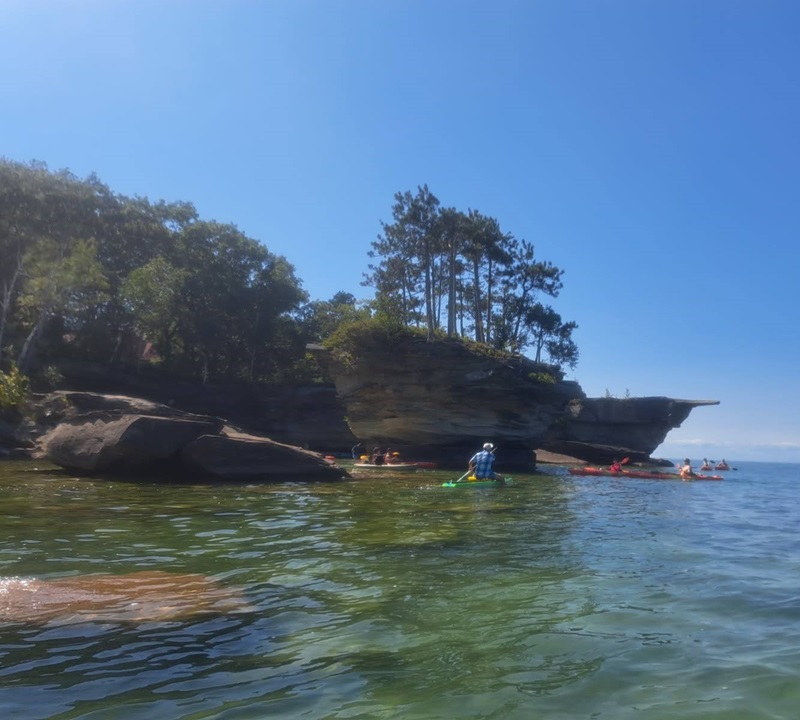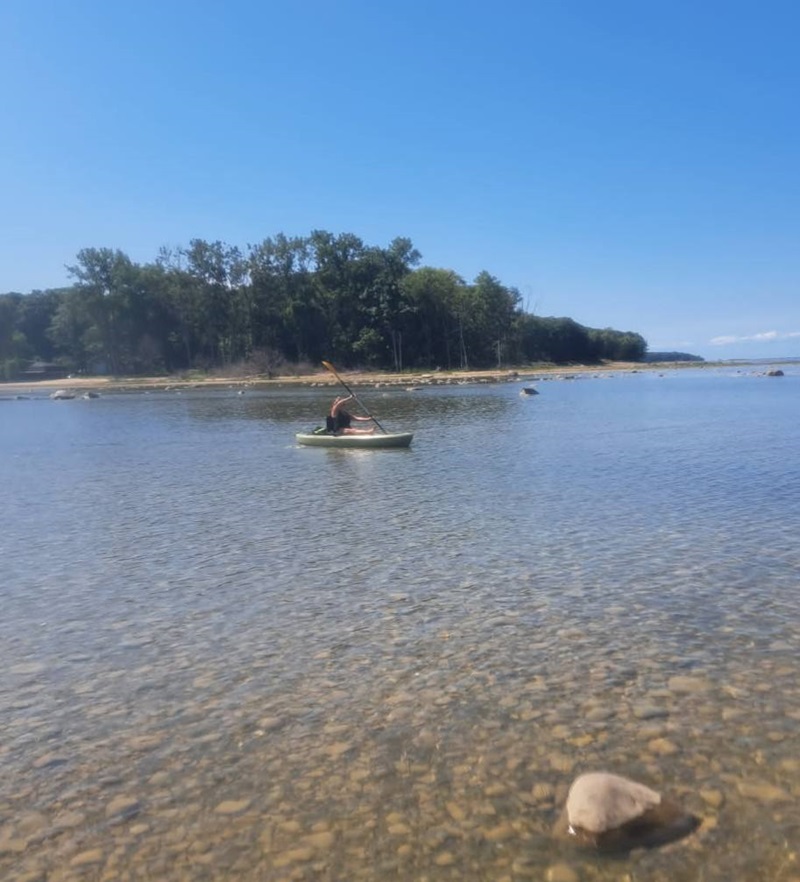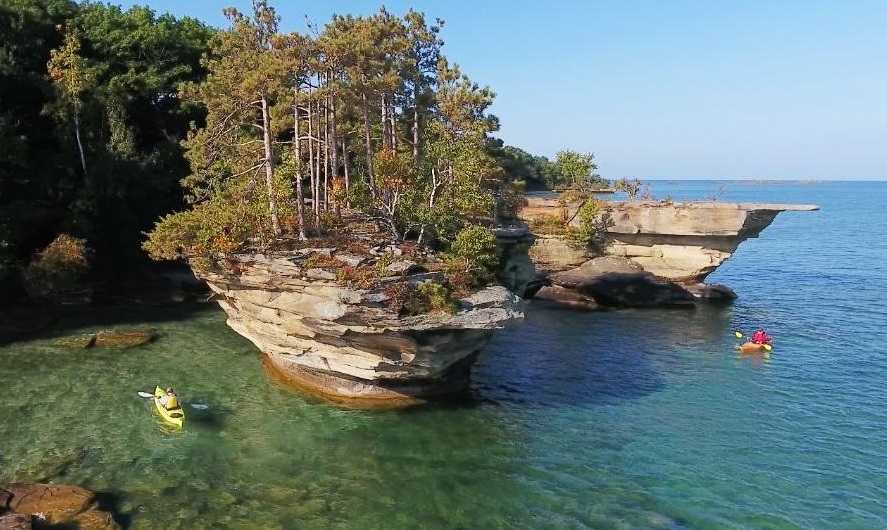Few places in Michigan are as eye-catching as Turnip Rock. This giant stone sits in the blue-green waters of Lake Huron, near Port Austin. Shaped like a big turnip, it was carved over hundreds of years by the waves of the Great Lakes.
You can’t reach Turnip Rock by car or trail. The only way is by water. That makes it feel like a secret spot—perfect for travelers who love quiet, natural places.
In this guide, you’ll learn about its story, why it matters, how to get there, and tips for your trip.
Quick Answer: What Is Turnip Rock?
Turnip Rock is a limestone stack in Lake Huron near Port Austin, Michigan. Accessible only by kayak, paddleboard, or boat, the formation resembles an upside-down turnip due to centuries of erosion. It is one of Michigan’s most photographed natural wonders and a must-see stop on a Lake Huron adventure.
Geological Story of Turnip Rock
Turnip Rock began forming over 10,000 years ago, when glaciers carved out the Great Lakes basin. Over time, Lake Huron’s waves slowly eroded the limestone shoreline, undercutting weaker rock layers at the base.
This process left behind a narrow pedestal topped with a wide crown of vegetation. The result? A natural “turnip” balanced in the water — similar to Canada’s Flowerpot Island formations. Its fragile shape is a reminder of how water and wind sculpt landscapes across centuries.

The Natural Beauty of Turnip Rock
The trip to Turnip Rock is as magical as the rock itself.
When you leave Port Austin Harbor, your kayak glides into the wide waters of Lake Huron. Time feels slower here. The lake shines in bright greens and blues. The water is so clear that you can see fish swimming below and sand ripples on the bottom.
As you paddle along the “Thumb” coastline, tall limestone cliffs rise above you. Waves have shaped them into caves, arches, and small alcoves. You’ll also pass Broken Rocks, a group of sharp stone towers that look like scattered art pieces. Birds circle overhead, cormorants rest on the cliffs, and trees lean over the edge with roots wrapped tight in stone.
Then, at last, Turnip Rock appears. It looks unreal—a tall limestone pillar topped with wind-bent trees. Its base is thin from years of waves, yet it still stands strong. Against the open lake, it feels both fragile and bold.
Why people love it:
- Scenic Appeal: A one-of-a-kind limestone wonder framed by cliffs and turquoise waters.
- Photography: Golden morning light and fiery evening sunsets make for unforgettable photos.
- Up-Close Wildlife: Birds nest in crevices, while fish and grasses thrive in the crystal-clear water below.
Even the weather shapes the experience. On calm summer mornings, the water mirrors the sky, making each stroke smooth and reflective. By afternoon, breezes ripple across the lake, adding sparkle to the surface. In autumn, crisp air and crimson shoreline trees create a dramatic contrast against the turquoise water, making the journey as memorable as the destination.

The Journey, Step by Step
- Launching from Port Austin Harbor
Most paddlers start at Port Austin Harbor or Bird Creek Park, where outfitters rent brightly colored kayaks. The first strokes are gentle, setting a rhythm for the 7-mile round trip—manageable for most on calm days. - Hugging the Cliffs of the Thumb
The route follows rugged limestone walls layered with history. Moss, wildflowers, and twisted tree roots cling to every crack, while caves and arches invite curiosity. - Broken Rocks: Nature’s Sculptures
Midway, you’ll pass Broken Rocks, a cluster of jagged formations jutting from the lake. Their shapes change with the light, and many paddlers drift here, cameras in hand, to soak in the eerie beauty. - Clear Waters Beneath Your Kayak
Closer to Turnip Rock, the water transforms into brilliant shades of blue and green. Sunlight filters through the depths, revealing schools of bass and perch weaving between underwater grasses. - The Arrival: Turnip Rock Revealed
Suddenly, there it is—Turnip Rock itself. Slender at the base, wide at the crown, and crowned with resilient trees. It’s a sight that silences most paddlers; some float quietly, others capture the moment at sunrise or sunset when the rock glows with otherworldly color.
The Return Journey
The paddle back feels gentler. The cliffs, caves, and Broken Rocks take on a new personality in the changing light. For many, it’s a meditative glide back to shore—a final chance to let the experience sink in before land replaces water.
Practical Visitor Logistics
Location: Off the coast near Port Austin, Michigan, at the tip of the Thumb.
Parking: Paid parking available at Port Austin Harbor & Bird Creek Park (avg. $5–10/day).
Facilities: Restrooms available at launch sites, but none along the water route.
Kayak Rentals: $30–50 for single kayak; $45–65 for tandem (half-day).
GPS Tip: Enter Port Austin Harbor Kayak Launch for easiest directions.
How to Visit Turnip Rock
By Kayak (Most Popular)
- Distance: 7 miles round trip.
- Time: 2–4 hours depending on experience and weather.
- Rentals: Local outfitters like Port Austin Kayak provide gear and safety equipment.
- Difficulty: Moderate — best on calm days.
By Paddleboard or Small Boat
Paddleboards are available from local marinas. Small boats are permitted, though kayaking offers the best experience.
Important Rules & Safety
- No climbing: Shoreline is private, and climbing damages the fragile rock.
- Best Season: Late May–September.
- Safety Tip: Always wear a life jacket and check wind forecasts before departure.
Best Time to See Turnip Rock
| Season | Conditions | Pros | Cons |
| Summer (Jun–Aug) | Warm water, long days | Perfect weather, vibrant colors | More crowds |
| Spring/Fall (May, Sep–Oct) | Cooler, colorful foliage | Fewer people, striking landscapes | Chilly water |
| Winter | Ice, wind, dangerous conditions | ❌ Not recommended | Unsafe |
⏰ Pro Tip: Visit in the morning for calm waters and golden light photography.
Accessibility & Family Tips
- ✅ Beginner-friendly on calm days.
- Great for families with older kids who can paddle 2–3 hours.
- Not suitable for toddlers or people with mobility challenges.
- Pets allowed in kayaks but consider safety before bringing them.
Conservation & Responsible Tourism
Turnip Rock is fragile. Even small actions can speed up erosion. Visitors should:
- Stay in the water. Do not climb or stand on the rock.
- Leave no trace. Take your trash and respect the animals.
- Support green rentals. Many local outfitters use eco-friendly practices.
By following these simple rules, you help protect one of Michigan’s most loved landmarks for the future.
Other Natural Attractions Near Turnip Rock
Port Crescent State Park – Sandy beaches, hiking trails, and a Dark Sky Preserve.
Broken Rocks – A nearby cluster of limestone formations.
Pointe Aux Barques Lighthouse – A historic site with sweeping lake views.
Sleeper State Park – Great for camping, picnics, and family hikes.
FAQs About Turnip Rock
Is Turnip Rock public or private?
The rock is in Lake Huron, but the land around it is private. You may only see it from the water.
Can you walk on Turnip Rock?
No. Climbing is harmful and illegal. Please enjoy it from your kayak.
How long does it take to kayak there?
Most trips take 2–4 hours round trip.
Is Turnip Rock safe for beginners?
Yes, on calm days. Many outfitters offer beginner gear and guided tours.
Conclusion
Turnip Rock is more than a spot to see. It is an adventure that mixes Michigan’s wild beauty, calm waters, and fragile rock into one trip you will never forget.
Kayaking here is not just about reaching the rock. It is about enjoying Lake Huron—its cliffs, its water, and its wildlife.
Visiting Turnip Rock also means caring for it. Respect the private shoreline. Stay off the rock. Take your trash with you. These simple steps help protect this limestone wonder for the future.
Whether you live nearby or travel from far away, Turnip Rock offers more than a photo. It is a reminder that the best places are reached slowly, by paddling forward, and by enjoying the journey itself.




